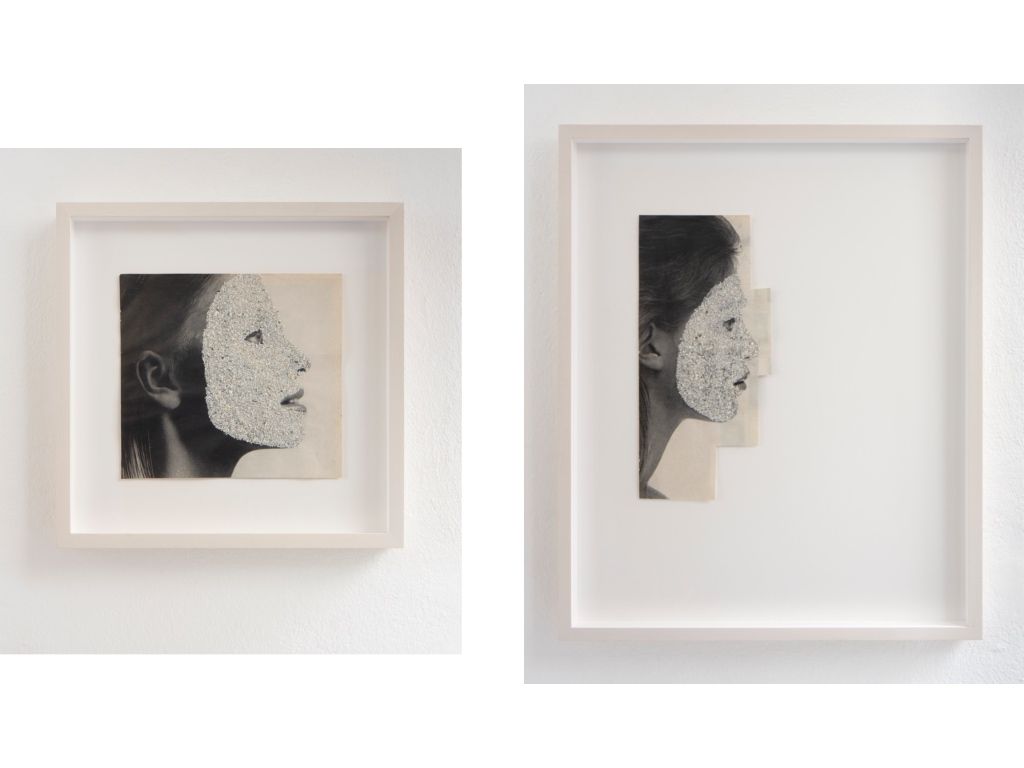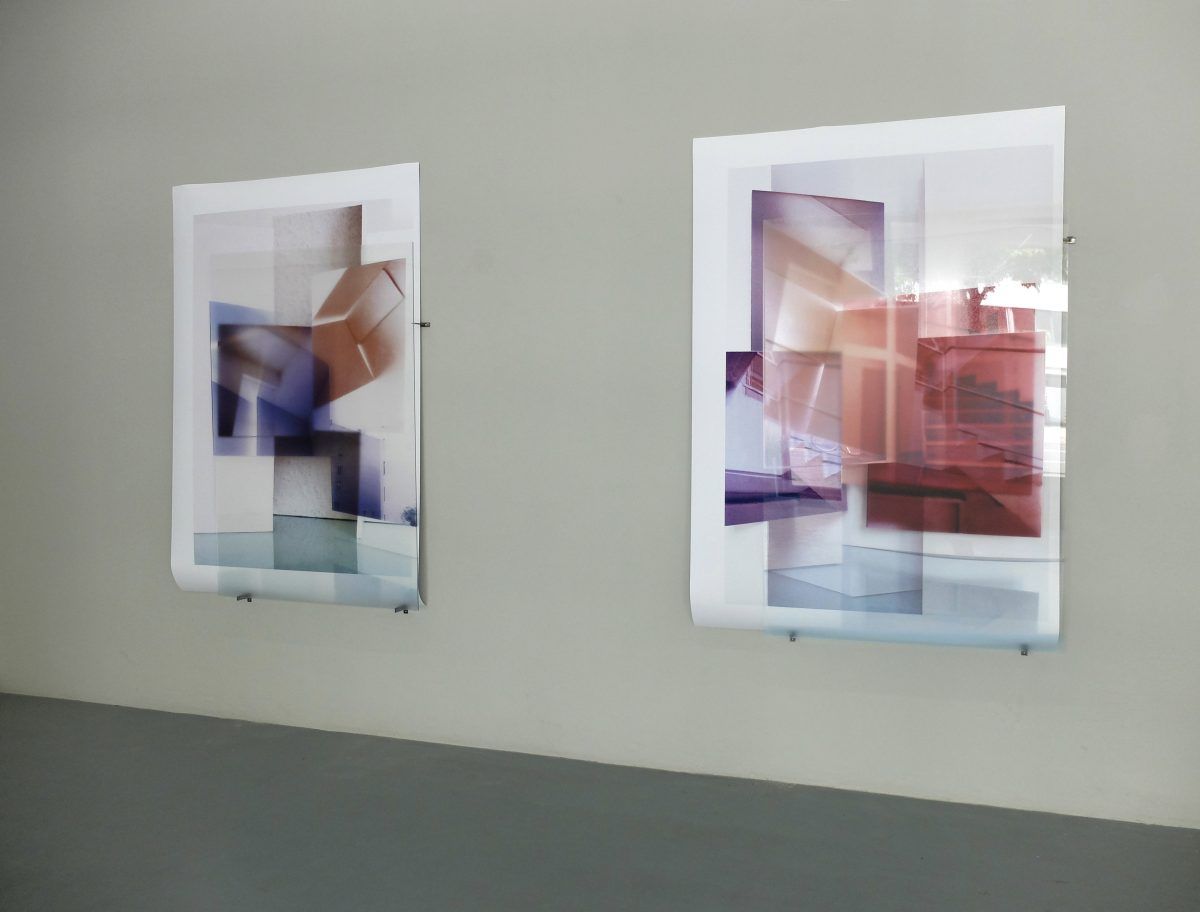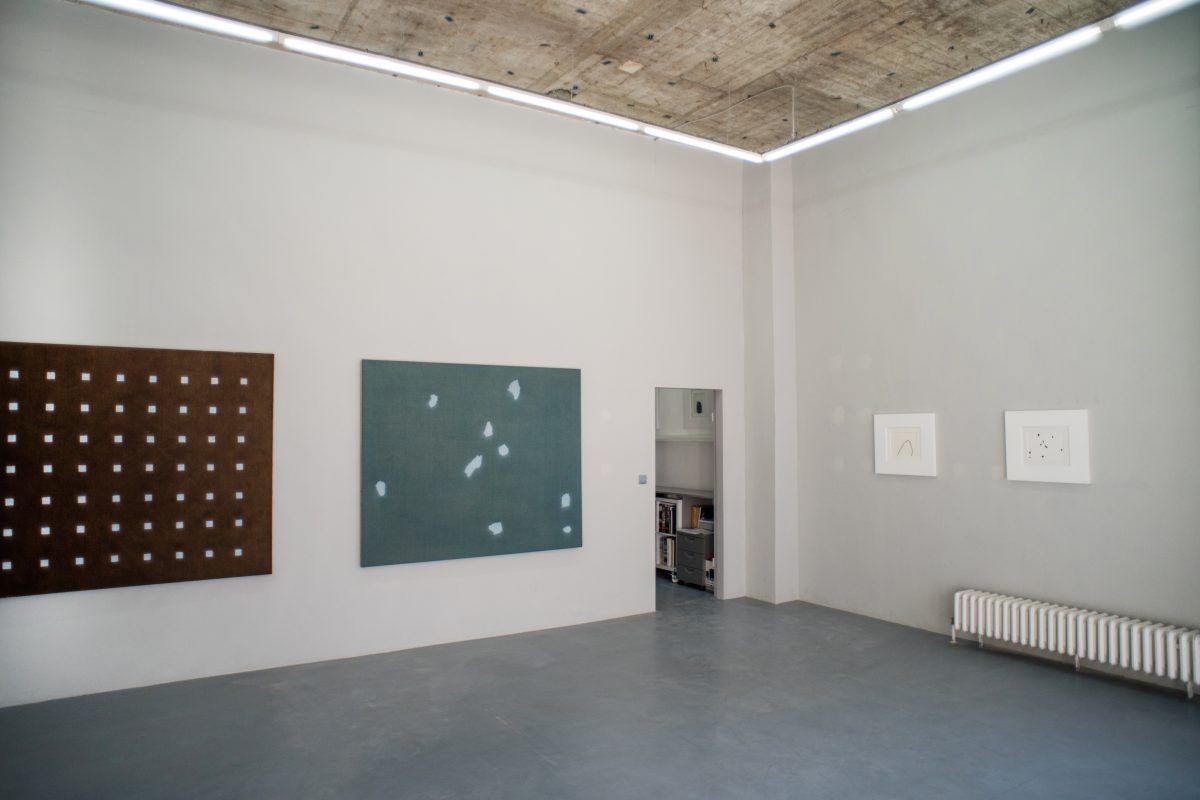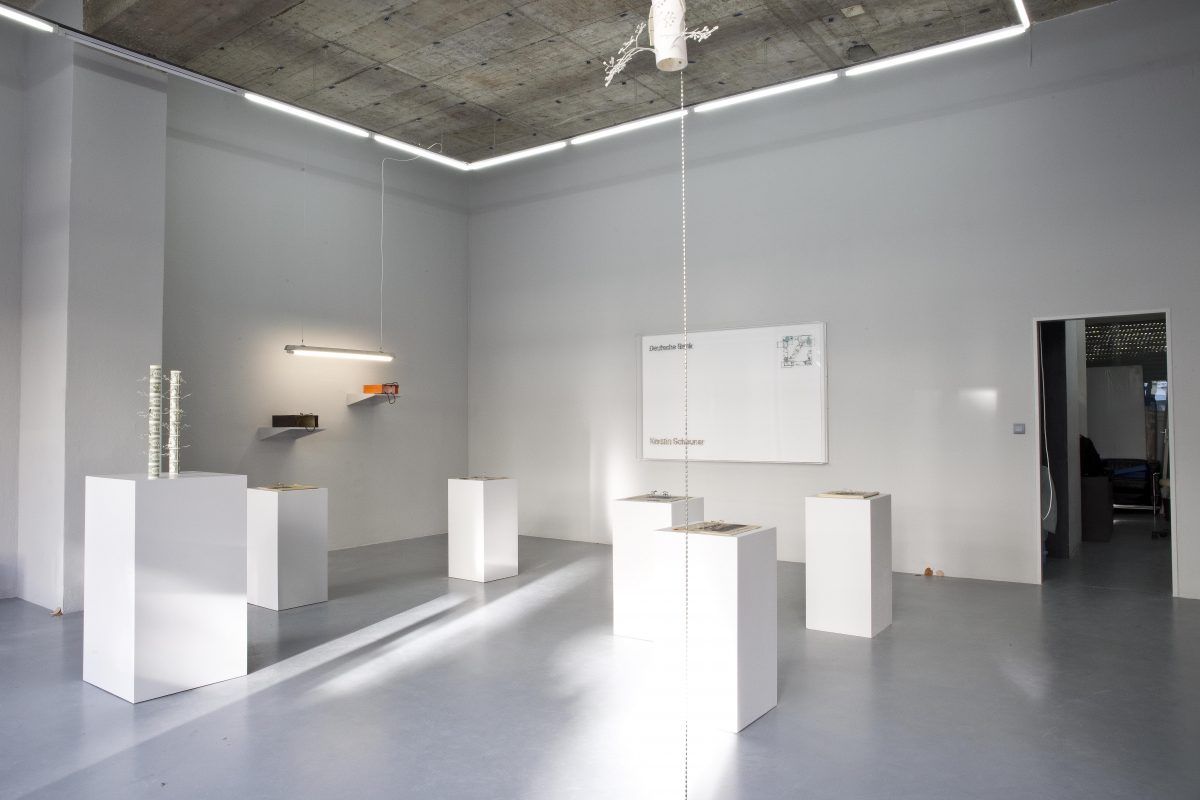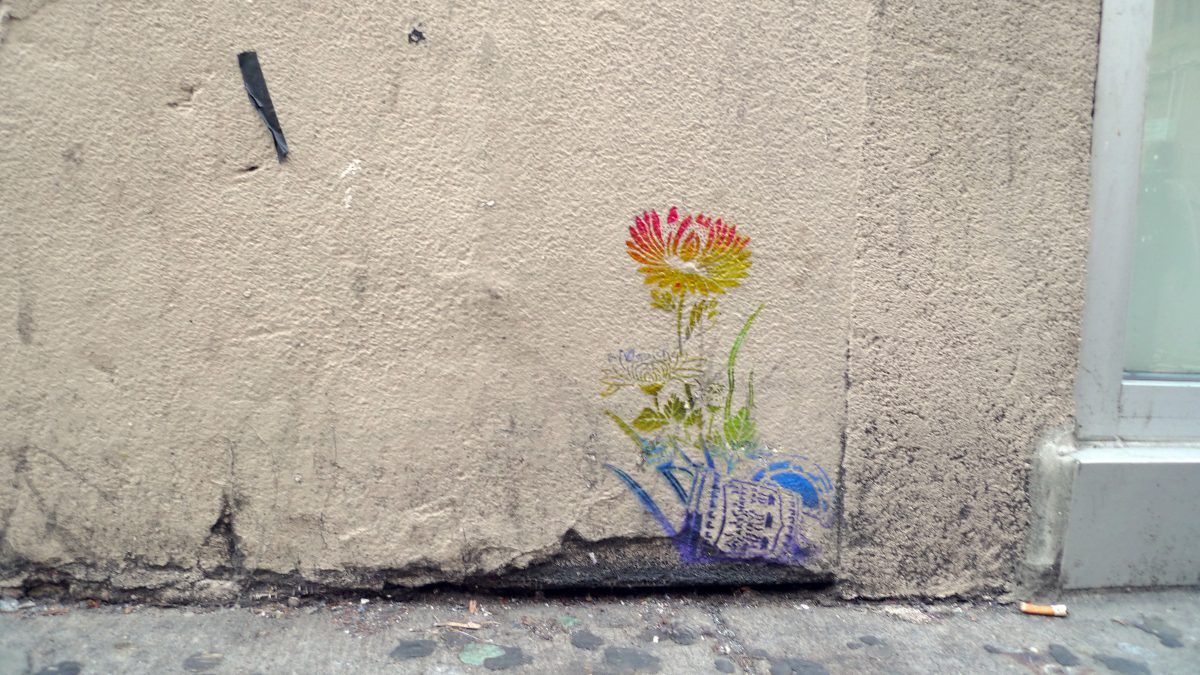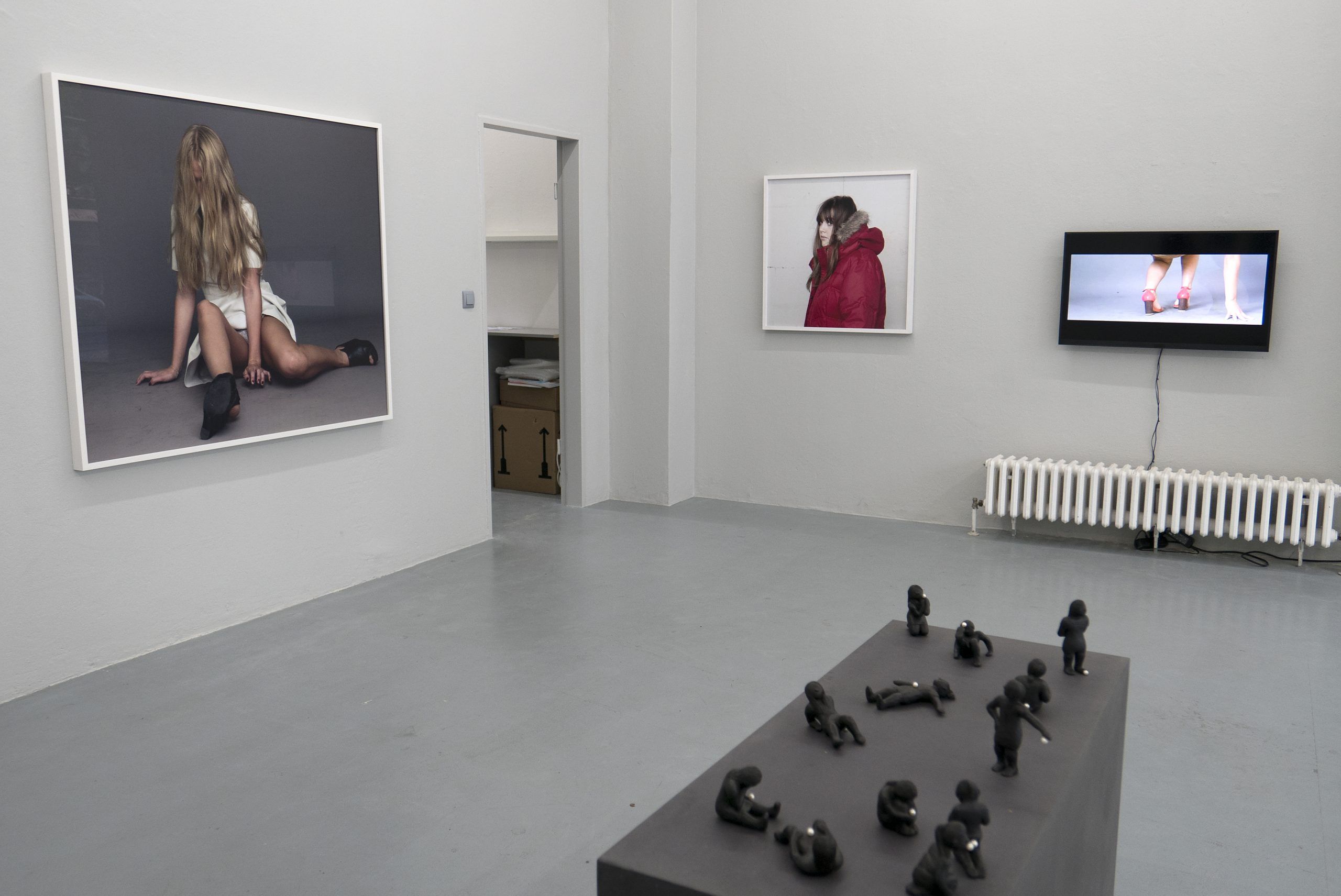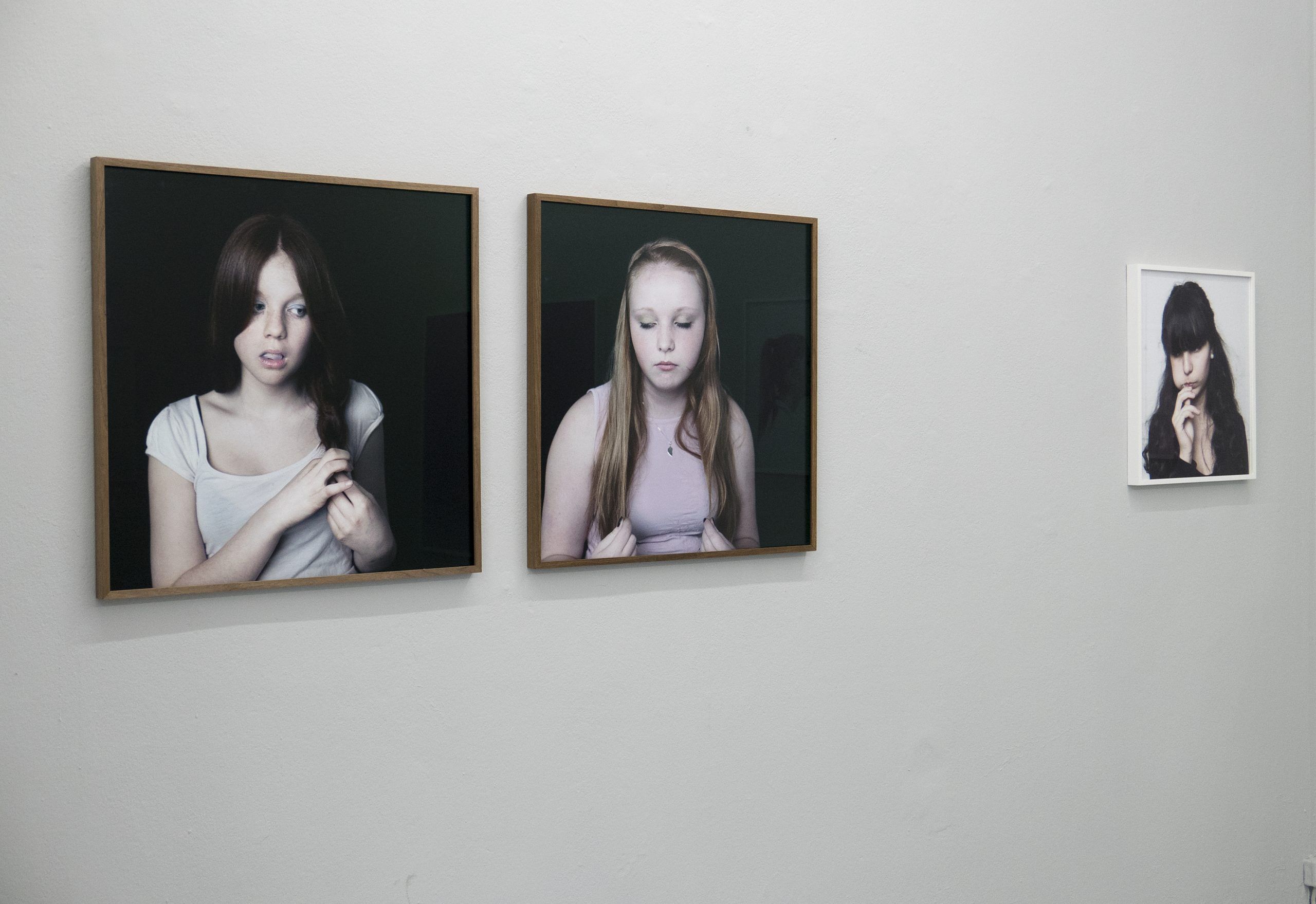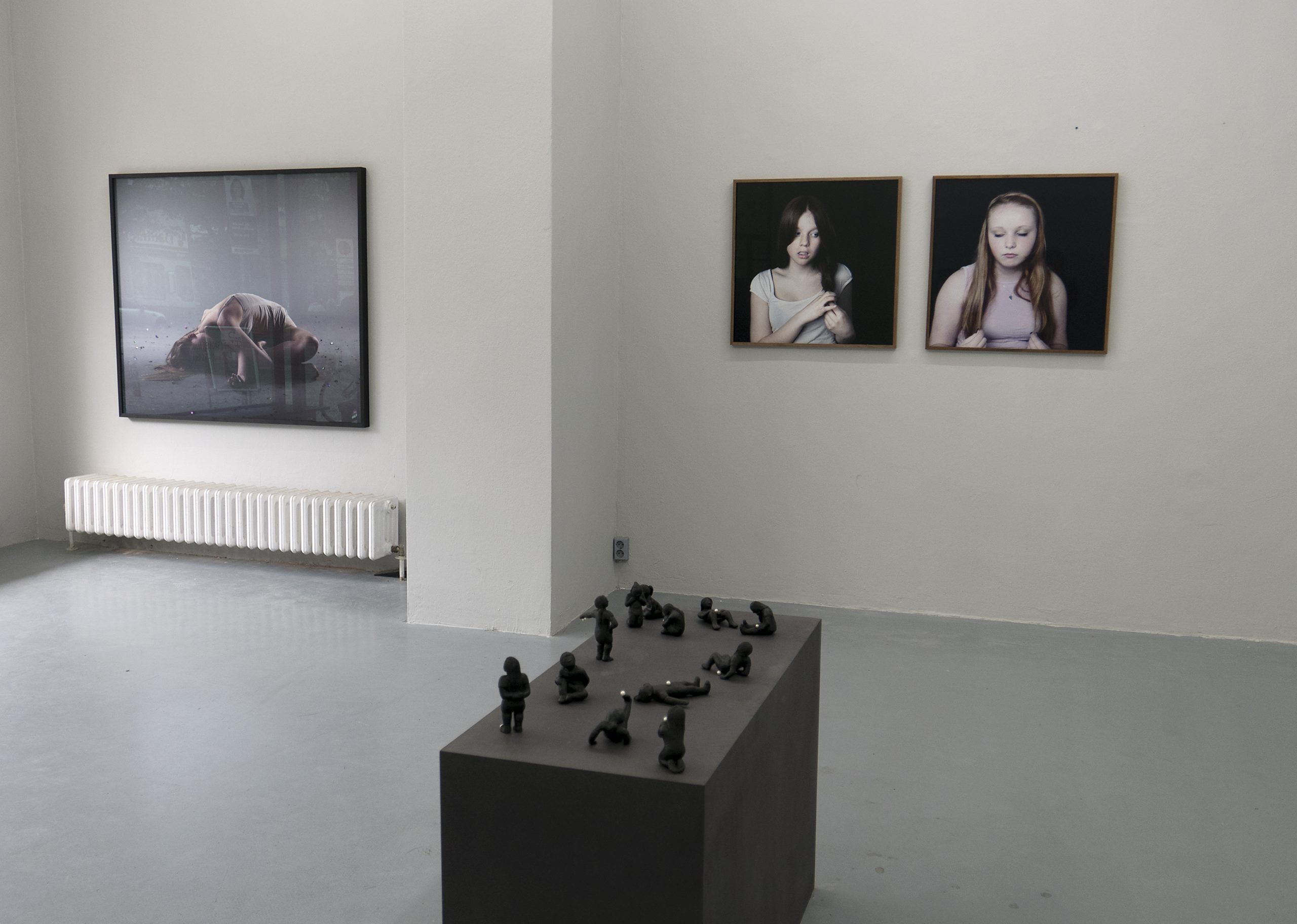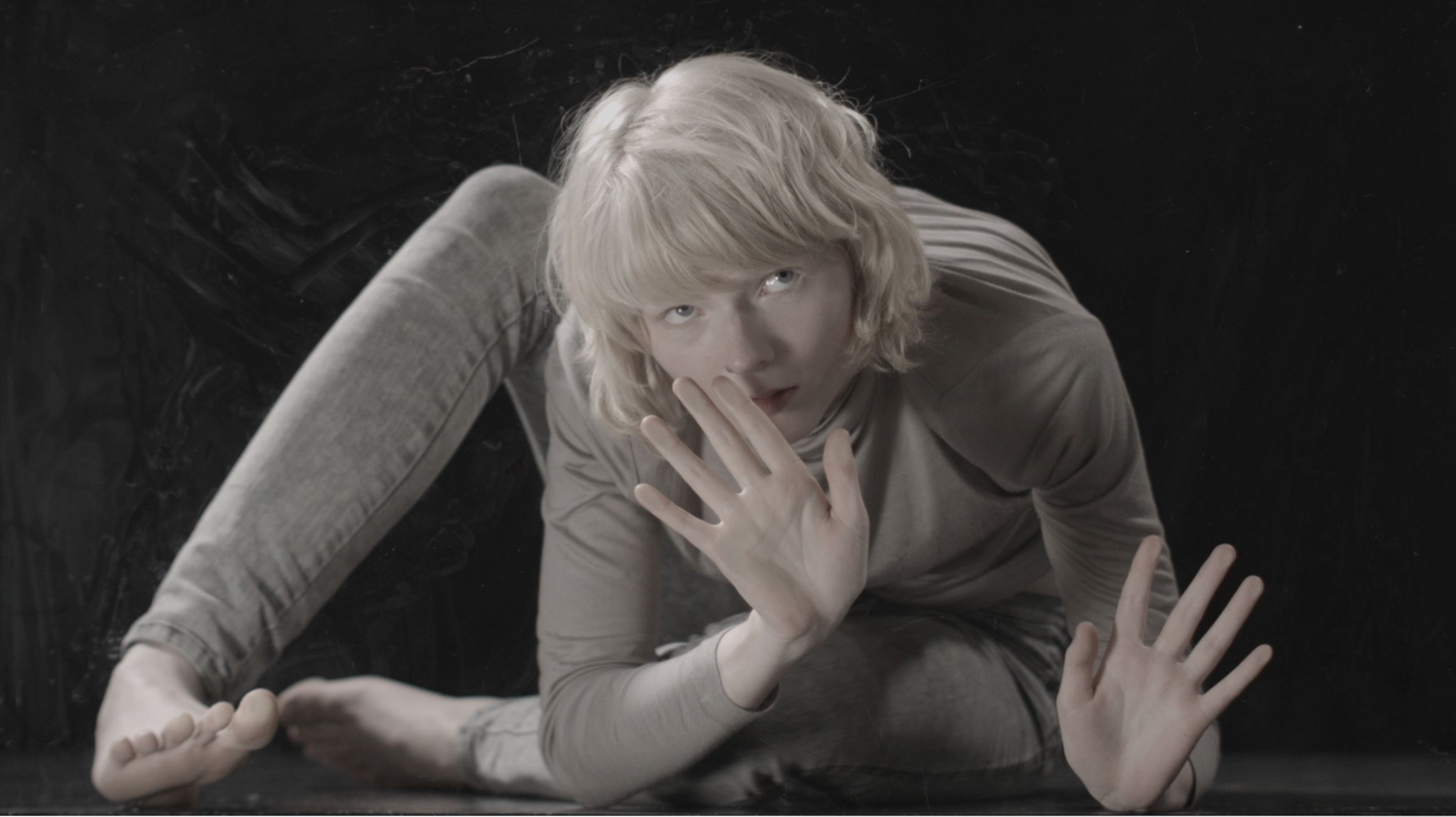Past Exhibitions
Gerry Johansson + Johan Röing
PHOTOGRAPHY AND SCULPTURES
November 6 – December 21
As a symbol of continuity and timeless aesthetics, sculpture enters a stimulating dialogue with photography, which by its very nature aims to capture the momentary and the ephemeral. The geometric lines of Johansson’s monochrome photographs are continued in Röing’s colorful sculptures, creating a system of reciprocal intervention.
In his precisely composed photographs of idyllic landscapes, abandoned peripheries, and urban environments, Gerry Johansson visualizes a phenomenon recognized as an abstract concept that is difficult to grasp – culture. In doing so, he often portrays everyday objects and sceneries in his black-and-white photographs, which often go unnoticed by the wandering eye. The social-historical approach reveals cultural structures and hidden levels of meaning that can only be deciphered in the deeper layers of what is shown. The cultural and visual differences between the landscapes portrayed, such as Mongolian Ulan Bator or Swedish Kvidinge, are unmistakable. Johansson’s idiosyncratic visual language aesthetically connects the places and allows the viewer to decode the cultural differences between the landscapes. As an encyclopedia of his travels, the photographs reflect the local and national history of the landscapes portrayed and connect the different places aesthetically and visually.
Johan Röing works predominately with the material wood. His sculptures emerge from a processual intuition in an ablative procedure. In recent years, his sculptures have increasingly developed from figurative works to a higher degree of abstraction and are reminiscent in their formal and pictorial language of artworks by Die Neuen Wilden, who emerged in Germany in the 1980s. His virtuoso handling of the organic material wood and the increasing abstraction always lend the sculptures something archaic and mysterious. At the same time, his work is in a constant process of change and transformation. From time to time, the sculptor returns to earlier works by reconsidering older sculptures and then reworking them. In his recent works, Röing is working and experimenting with the material glass and presents his glass sculptures for the first time in the group exhibition.
Gerry Johansson (*1945) studied graphic design at the School of Design and Crafts in Gothenburg and worked as a graphic designer for several years before turning to photography in the mid-1980s. His photographs have been published in more than 30 publications, including American Winter (2018), Tokyo (2016), Antarctic (2014), Germany (2012), Sweden (2005), and America (1998). Johanssons‘ works have been presented in numerous exhibitions internationally, including Spazio Labo in Bologna (2020), ICO Foundation in Madrid (2019), Museum of Modern Art in Borås (2019), MiCamera in Milan (2019), Lothringer13 Halle in Munich (2019) and Kunsthalle Rostock (2018). He is the recipient of numerous prizes and awards, including the Lars Tunbjörk Prize (2019) and the Skåne Kulturpris (2011).
Johan Röing (*1958) was born in Malmö and spent his childhood in Germany. He studied among others with Tony Cragg at the State Art Academy in Düsseldorf from 1979 to 1986. He returned to Sweden in 1996 and now lives in Fuglie on Söderslatt as well as in Malmö. His works have been presented in numerous exhibitions, including Trelleborgs Museum (2020), Kunsthalle Falsterbo Strandbad (2020), Moderna Museet Malmö (2019), Olseröds Konsthall (2018).
Lotta Antonsson | I AM SILVER
September 11 – October 30, 2021
The exhibition I am Silver presents artworks that deal with the search for identity and the objectification of womanhood. Based on the aesthetics of the 1960s and 1970s – a time of social upheaval – Lotta Antonsson complements vintage photographs from her private archive of fashion, erotic and lifestyle magazines with natural materials such as stones, corals, and shells. The artist explores in her work the historical and photographic representation and stereotyping of the female body under formal and psychological aspects. A recurring theme in her work has involved feminist perspectives reconstructing cultural treatment of the female body in particular.
Lotta Antonsson (*1963) belongs to a generation of artists who emerged in the early 1990s and addressed the objectification of women. She studied fine arts and photography in Stockholm at the University of Arts, Crafts and Design and at the Royal Art Academy in Copenhagen and she was a professor of photography (2007-2016) at the Valand of Art and Design in Gothenburg. Her works have been in numerous international exhibitions, including the Västerås Konsthall (2020), the Latvian Centre for Contemporary Art in Riga (2019), Photobiennale in Brighton (2010) and the Daegu Photo Biennale in South Korea (2012).
Martin Mlecko |
„… Den Rest muss dann jeder selber entscheiden.“
Exhibition: July 16 – September 02, 2021
Finissage: September 01
Martin Mlecko (1951 – 2016) understood art as the last utopian space. He considered it necessary for artists to actively intervene in social and political processes. With this attitude, he realised a series of collaborative projects from the late 1980s onwards that opposed the de-solation of community life, the loss of established social places, and the greed for profit.
At the same time, he created a photographic and cinematic oeuvre that followed the spirit of these projects. After sea voyages on cargo and research ships that took him as far as the Arctic Sea and the Pacific, he increasingly concentrated on images of retreat. The private sphere and its conditions became the defining theme. While for many years it was the public sphere that inte-rested Mlecko, he finally devoted himself to observing individual lives and how they were shaped. The repositories of personal memories, of emotions, and of the self-awareness that flows into an infinite number of decisions every day – and can be very consequential there – became the motif. Works from this context have become pictorial ciphers of a broad social romantic oeuvre. Mlecko thus gave a variety of hints. ‚The rest,‘ he thought, ‚is up to each person to decide for themselves.‘ Martin Mlecko was an investigative artist, conceptual artist and filmmaker working in a range of media. His photographic oeuvre is a collection of series without itself being serial in struc-ture. He is both traveler and observer, sometimes also seeker, whose creative products defy relegation into the clearly defined pigeon holes of the art industry. Among his art forms are large-format installations and small-scale documentation, both representational and abstract. He taught staged photography at the Kunsthochschule Berlin-Weißensee. Wolfgang Schöddert
The exhibition is kindly supported by NEUSTART KULTUR Stiftung Kunstfonds
![]()
![]()
Yvon Chabrowski |
Situated Knowledges or the Attempt of an Encounter
May 29 – July 10, 2021
The exhibition Situated Knowledges or the Attempt of an Encounter presents the award-winning video sculptures LEVEL, HORIZONTAL, SWAYING and THE APPROPIATE BODY by Yvon Chabrowski. In her expansive video sculptures, the artist makes the border space of media formats spatially tangible. Chabrowski interweaves performative and documentary strategies to create an open, sculptural space of negotiation that invites beholders to situate their body in relation to the media surfaces and bodies represented.
The exhibition was kindly supported by NEUSTART KULTUR Stiftung Kunstfonds
![]()
![]()
Inka & Niclas | Luminous Matter
March 16 – May 22, 2021
Our notion of desirable scenery worldwide has been made possible not only by travels to spellbinding locations but by our consumption of nature via technology. It is through the camera lenses and the digital screens that we experience nature and confirm our existence. In their latest works, Inka & Niclas continue their examination of nature as a cultural construct, but the focus now lies on milieus connected to the artists own childhood and heritage – a partly introspective approach with a micro/macro perspective, coherent with a current universal strive towards understanding and being close to one´s local habitat. The exhibition consists of works from the three individual artwork series Luminous Matter, Family Portraits and Liquify, that the artist duo has worked on simultaneously.
In contrast to their earlier works, often situated in large scale grand scenery outside of Sweden, the series Luminous Matter (that lends its name to the exhibition) centers around depictions of wildflowers and weeds found closer to the artists´ native surroundings. The exploration through the camera has led the duo´s interest in several wildflower species found along the roadside in Sweden – flowers so common in the Swedish scenery, that they almost go unnoticed in our collective consciousness. Or have we just not seen enough wildflowers documented on our screens to interpret them as desirable? The three represented plant species Smörblomma (Buttercup), Hundkäx (Cow Parsley) and Midsommarblomster (Woodland Geranium) blossom and peak during the summer solstice of the Northern hemisphere, a period associated with almost constant light throughout the day and night. As a glitch in our reading of the image, the wildflowers are depicted in a manipulated full nighttime scenario as opposed to the images of the flowers that we are used to seeing.
The title Luminous Matter points far out in cosmos and eternity, contrasting the fragile, short-lived flowers. By throwing retro-reflective powder into the scene and illuminating it with the flashgun, the artists superimpose an explosion of glowing particles resembling popular space imagery or an exploding nebula from the NASA archives. The traces of the powder emphasize and highlight the delicate structures that otherwise go unnoticed and navigate the chaos that makes up ordinary roadside vegetation.
By paying attention to local low-status wildflowers and their natural habitat, the artists have delved into the details of the photograph even further. As pictures contain a considerable amount of information, the post-production of the photograph may here be regarded as an excavation of the image – an immersion in a microcosmos that demands an extensive amount of time spent with the details of the subject matter.
Family Portraits is a collection of self-portraits taken during the artist’s travels to idyllic panoramic settings across the world. The series is a continuous long-term project where the initial romantic scenery has turned into darker settings over time, like a suggestive crime scene in a Scandinavian Noir novel. It is a continuous investigation of how we perceive and save our memory of nature through the mediated picture, but also how we use the mediation of nature for self-identification. ‘I´m one with nature, you can see it on my Instagram account’. In the latest addition to the project, Inka & Niclas, along with their two children, continue their travel to collect self-portraits, this time in the Scandinavian landscape. All dressed up in full-body suits that bounce the light of the flashback into the camera lens, the shapes of what we read as a family constellation indicate anonymity. The four characters pose in front of grand vistas – an overwhelming fjord panorama at dusk, a snow-covered landscape with Polar stratospheric clouds as a backdrop, a meadow at night, among spring onions in full bloom. As with many photographs throughout history, these images serve as evidence that four bodies were present in the scenery. Simultaneously we experience the four individual’s absence in the photographs as their features are erased – like radiant phantoms waiting to transcend to another dimension. The role of nature as an enduring source of idealization remains untouched.
Abstracting the ordinary and enabling tools to the photographic image and its psychological mechanisms have been an important feature throughout Inka & Niclas’ work. In the photographic sculpture-series Liquify, the seemingly collapsed photographs have been placed on the wall, as if wet towels hung to dry. Their glass-like surface suggests materiality more alluring than the mundane shape. It appears gravity has decided their form. A complete understanding of the medium proves to be difficult, as the objects are substantially manipulated into new materia in their own right.
Parts of the romantic scenery are visible, and we can only imagine the beauty of the initial image, while we are deprived of the complete motif. Glimpses of pink blushing snow or raw wildflower bouquets in black and white serve as clues to the depictions partly hidden within the objects. The viewer is thus invited to fill the void with his or her desires and ideas of the perfect shot. And it might as well be for the best because with all our possibilities of manipulating the image, it is hard to get the feeling of content – one can always find a better photo filter or angle. The title Liquify points to the liquid shapes of the photographs, but it is also a reference to the Photoshop filter of the same name, used for heavier types of image manipulation within the beauty industry.
Olga Krzeszowiec
The exhibition is kindly supported by NEUSTART KULTUR Stiftung Kunstfonds
![]()
![]()
Susa Templin | Premises
June 13, 2020 – September 06, 2020
Susa Templins exhibition „PREMISES.“ presents her new, multi-layered series “Spatial Abstractions” made of printed plexiglass and pigment prints. Templin developed this group of works in 2019 while on a scholarship at the Berlin Foreign Office’s so called ,,Roof Studio.”
Templin creates her “Spatial Abstractions” using large-format, photographic collages which overlap in scale and material, representing a further development of her multidimensional examination of photography. These works focus on the spatial exploration of the two-dimensional photographic image. Templin addresses the contradiction between space and surface in her art and develops new forms on the surface of her transparent image carriers.
In her photographic works Templin conceives of new spaces and also utilizes sculptural working methods [in their realization]. For these pictorial constructions, the artist draws on her archive of self-taken, analogue colour photographs, all of them images of places and spaces the artist inhabited or encountered. They appear as penetrating, complementary or distorting memories and associations. Templin’s works thereby question the conditions of architecture:
“My pictorial spaces are constructed from experiences that have become pictorial, and using new transparent materials, they create realities layered in colour and perspective.”
Dawid | Enlargements
March 14, 2020 – June 06, 2020
Between 2005 and 2008, the Swedish photographer/artist DAWID (Björn Dawidsson) created a series of photo-based paintings (acrylic on canvas), in which he developed his own technique using pale colours, which he partialy blurred.
The focus of his painting is on the canvas surface – as well as on the surfaces of the silver gelatine prints of his analogue black and white photographs. Tinted, dirty, shiny and matt surfaces influence the experience of the subtle motifs. The Dorothée Nilsson Gallery presents these paintings for the first time in Berlin. The exhibition also includes photographs by DAWID.
Photography and painting from a new perspective
The paintings from “ENLARGEMENTS” are a kind of colored enlargements of the black and white photographs that have become DAWID’s trademark. Although the artist always showed great interest in analogue colour photography, he was not satisfied with its technical possibilities – the plastic, insensitive and cold surfaces of the c-prints did not correspond to his artistic ideas. His painted works can be read as translations, as enlargements of DAWID’s black and white pictorial world, to which he added colour.
The black and white photos are not neutral; DAWID often coloured them in shades of blue, green or sepia. When enlarged and transferred to the medium of painting, these tones are further intensified. When the pictures are viewed, small-format series give way to new dimensions and vice versa. The dialogue between the media of photography and painting conveys a deeper understanding of DAWID’s original perspective, which has inspired art criticism as well as Scandinavian and international audiences.
The new series of works “OAS”
In 2015 DAWID exhibited the series “Arbetsnamn skulptur” (Working title Sculpture) at Pace/MacGill Gallery in New York together with works by Hiroshi Sugimoto and Harry Callahan. When DAWID returned to painting in a new studio in 2019, he returned to the classic series that had made a big impression in 1989 when it was first shown at the Thielska Gallery in Stockholm. With his new series of works “OAS” he continues this project and creates new, sometimes reduced, sometimes more daring still lifes.
Text: Linda Bergman, editor-in-chief for the magazine VERK, art scholar and writer/critic.
Martina Hoogland Ivanow | Early Reading
January 11, 2020 – February 29, 2020
Martina Hoogland Ivanov’s art deals with the representation of transparency. The photographs the artist shows in the Early Reading photo book are images of tactile stimulation and touch. She describes the traces we leave behind when we get up from a chair, when one hand releases the arm she just touched, or when bodies come into contact with other people’s bodies in a confined space as warm shadows. Experiences like these can be poetic or touching.
Thermal imaging cameras are needed to make them visible. Thermal imaging cameras do not record light but heat. Technology is not only of massive importance for science, its value is also of an aesthetic nature. X-ray and MRI equipment allows insights into the body without penetrating it or cutting it open. Using radiation, magnetic fields and radio waves, they show the body as it is not perceptible to the naked eye. Do the recordings of a thermal imaging camera make transparency perceptible?
The technique was artistically used by the American photographer Arthur “Weegee” Fellig, whose infrared film images of people in dark cinemas became widely known. His colleague Minor White also worked with infrared images, for example in Sequence 10 from 1955. One of the images published in this context is entitled Black Sun. Martina Hoogland Ivanow’s film Interbeing as well as the photo book Early Reading refer back to the motif of the black sun and are located in the photographic tradition of White. In Hoogland Ivanow’s works, the blacksun stands for a moment of pause that lasts only one breath.
The title of the Early Reading photo book recalls the early reading exercises of childhood. Hands that hold the reading child; a memory that we have memorized and that we recall again and again, that promises us confidence, joy of touch, and protection from danger. Martina Hoogland Ivanov examines the search of our bodies, both for closeness and for distance. Besides these pictures, the book shows photographs showing demonstrations that took place on 01 May at Sergels Torg in Stockholm. The images of political activism open up a second perspective on the title Early Reading: First Contacts with Political Teachings and Theories. They are democratic processes that serve to understand and locate personal responsibility and social processes. The interaction of the various motifs in the photo book underscores the fact that thermal imaging cameras are not only instruments of artistic practice but also of structural surveillance.
From the Swedish text Värme-Skugga-Viskning published in www.Verktidskrift.se no: 01 2019 by Iréne Berggren, photo historian, author and curator
Yuken Teruya | My plan B is maybe my plan A
September 07, 2019 – December 21, 2019
For the exhibition “My Plan B is maybe my Plan A”, Yuken Teruya uses a mixture of various everyday materials to address such themes of contemporary society as consumer culture, globalism, and the environment. The title of the exhibition refers to a quote by President Donald Trump from an interview with Fox Business Network in which he commented on trade negotiations with China (June 26, 2019).
The title already reveals a lot, since Yuken’s works often contain a hidden political message. The subject of his work comes from everyday life, yet the chosen materials point to something very specific: monopoly bills, money trees, and even his shopping bags refer to to banks, capitalism and centers of political power. With his sprouts, he introduces something entirely natural into these hardened systems and criticizes them in a subtle yet effective manner. In so doing Yuken questions the power structures of our society, citing an interest in the intersection of nature and value, “in all of its abstract levels.” In his work “Chance ” he cuts Monopoly quotations into found leaves in Central Park. It’s an extension practice of playing with elements of MONOPOLY game, giving the power to a leave to be a potential “Chance” card . “It’s a part of the practice based on observation of every day scenery around us.”
His installation, “MINDING MY OWN BUSINESS,” was inspired by a headline in the New York Times. It portrays newspapers as a sculptural landscape of daily information – photos are cut out and transformed, sprouts grow from the newspaper’s surface and embody life, and a new narrative, one that also contains observations from the past, is formed. The latter reflect Yuken’s very personal and emotional response to such newspaper articles.
Julia Peirone | Girls – a female Gaze
April 27, 2019 – July 20, 2019
“In her work, Julia Peirone takes the viewer to the boundary regions of puberty.” (Niclas Östlind, 2017)
Since her debut at the turn of the century, Julia Peirones visual world is chiefly populated by girls or young women. Peirones series mirror aspects of vulnerability, shame and sexuality in a time that is heavily influenced by social media and their affects on the creation of identities. The artist is looking for the gap between reality and construction.
Julia Peirones oeuvre poses questions about the strengths and limitations of the photographic image and the way we encounter ourselves in them. The modern day visual culture favores self-glorification and an obsession with abstract ideals of beauty. In her photography, Julia Peirone focuses on these notions to explore young, mostly female teenagers search for identity.
Peirones work has a proximity to the moving image. Her photographic series often show casting situations and preparations. Retakes, fleeting moments and failures are given a prominent position. The pictures can hardly be defined as portraits in a conventional sense; rather, they investigate mental states and visual conventions that reflect the demands of the external world. The photographs often capture the frustration that young women suffer after having been imprinted by certain ideals.
The relationship between the model and the photographer, as well as those between the viewer and the viewed, is an aspect of several images by Julia Peirone. Their gazes almost never meet. The girls eyes are shut or hidden by their hair. Tight tank-tops and short skirts expose their skin. The artist stresses that “the girls in my pictures are victims of a gaze, but they are also strong and have power over your gaze”.
The exhibition displays photography, video, sculptures and text.
Henrik Strömberg | Vertical Matter
February 16, 2019 – April 18, 2019
On the occasion of the exhibition Vertical Matter by Henrik Strömberg, Dorothée Nilsson Gallery presents a new body of work conceived by merging the use of photography, sculptural volumes and re-evaluated materials.
The co-existence of the various media permits the production of different series. Sculptural pieces, photographs and collages are converging into a self sustainable biotope where each component becomes part of the whole.
The extension of Strömbergs practice, from the reconfiguration of pre-existing objects to the production of hand blown glass pieces, suggests the idea of a moment fixed: an action materialised from within.
While the photographs are depicting ephemeral abstraction of objects and natural elements, the expanding volumes – the core of the sculptures- are shaped and multiplied through the use of glass grid structures and plaster moulds. Linked to the idea of cellular division/mitosis, the various components are kept as witnesses of the process. The matter of the volumes, vertical, and augmented by paper stacks, expands as a layered compost.
# 5. The compost is:An oracle (a place that speaks or murmurs); the original assemblage; metamorphosis; a passage between the grid and the soil, between the actual and the possible; a temporary refuge.
Extract from THE COMPOST MANIFESTO, 2nd version, Jens Soneryd 2018
In Dialogue with Strömholm
December 15, 2018 – February 9, 2019
With works by Christer Strömholm (1918-2002), Dawid (*1949), Gerry Johansson (*1945), Henrik Strömberg (*1970), Håkan Elofsson (*1955), Inka und Niclas (*1985/1984), Julia Peirone (*1973), Linda Bergman (*1976), Martina Hoogland Ivanow (*1973), Sascha Weidner (1974-2015), Susa Templin (*1965), Thom Bridge (*1987) and Yuken Teruya (*1973).
Dorothée Nilsson Gallery presents four rare prints by the Swedish photographer Christer Strömholm from his first exhibition in Stockholm in 1965. They are displayed alongside selected contemporary artists. The ensuing “dialogue with Strömholm“ thematizes and reflects artistic aspects of this artist’s oeuvre in a unique way.
Strömholm the doyen of modern Swedish photography, and his extraordinary work occupies an important position in the history of international photography. His pictorial compositions depict a unique vision of the world, and they led to his association with the group of pioneering photographers founded by Otto Steinert known as “Fotoform.” Strömholm is known above all for his legendary photographs of transsexuals at the Place Blanche in Paris during the 1950s and 1960s. With relentless radicality, his black-and-white “photographic existentialism“ captivates the poetic charm of life’s rough realities. The secret of this existentialism often lies in the surreal forms that are interwoven with dramatic pictorial moments, moments in which people resemble fragile and illusory creatures who reveal themselves to the camera in all their ordinariness, imperfection and doubt. Strömholm regarded his environment with the eyes of an artist who simultaneously seeks confrontation with reality and establishes contact with his fellow man, as a basic principle in photography. “Each picture can be considered a self-portrait, a part of one’s own life.” (Strömholm, 1983)
There are also obvious parallels to the work of younger artists’ pictorial formulations: the magical presence of a tree branch by Inka and Niclas, or a door by Henrik Strömberg, reveals the fragility of being and the surreal moments of subjective experience, moments which are likewise inherent in the artistic understanding of Susa Templin and Yuken Teruya. In a similar way, Julia Peirone also thematizes identity in the self-interrogations of her youthful portrait pictures. And Sascha Weidner’s images raise existential questions in a similar was just as they enchant the eye. The disembodied heads of Strömholm’s pictorial world are also reflected by the cruel metamorphosis of the doll’s face in Linda Bergman’s work. Such graphic references result in a dialogue between the old master and the thirteen artists displayed in the exhibition.
Strömholm, as one of the main proponents of modern photography had already abandoned the documentary and narrative character of the medium behind and Dawid (Björn Dawidsson), as the founder of a postmodern understanding of photography in Sweden, find the genesis of their oeuvre in an experimental pictorial language. Contemporary positions such as those in the exhibition work in a wide variety of ways and against the background of today’s post-photographic understanding on the expansion of the medium into real existing space.
Text: Franziska Schmidt
Johan Österholm | Apparent Magnitude
September 26 – November 17, 2018
Presented in conjunction with the European Month of Photography, Österholm’s first solo exhibition in Germany integrates older and more recent works on the subject of light pollution. For many years now, and from various perspectives, Österholm has focused on light, the central yet least tangible element of his medium. Using astronomical observations, archival research and captivating punchlines, this exhibition presents experimental works, photographic landscapes and sculptural objects to remind us that light is not only natural, but also a source of political conflict with respect to the control of light and darkness within the city.
The three-part series Some Moonwalks (2017), for example, was created on the Isle of Sark in the English Channel. The island is considered a region with a natural, extremely dark night. On his nocturnal walks across the island, where the human eye can hardly see anything, Österholm’s camera was able to visualize the pale landscapes drawn by the clear moonlight on the island.
In recent works such as Concealer (2018), the perspective is reversed. It is not the essence of pure moonlight, but the dim light of urban street lamps that becomes the subject and artistic material. Lantern Smashers (2018) interprets the streetlight as a political symbol of control. In the 19th century, newly erected lanterns were sometimes demonstratively destroyed. Österholm’s pictures of sparrows that have occupied urban gas lanterns interpret today’s vandalism or decay as a memory of those struggles for darkness in the city.
The artist uses old astronomical negatives from observatories and exposes them using street lamps creating fascinatingly complex, black and white composite images. In Antique Skies and Untitled Lantern Pieces (both 2018) Österholm used a primitive method of early photography. For hours he exposed an astronomical yearbook and the glass pane of a street lamp with the negatives of those constellations that the light smog of the 20th century made invisible.
Concurrent with the exhibition at the Dorothée Nilsson Gallery, a selection of additional works by Österholm’s can be seen at the C/O Berlin’s group exhibition Back to the Future. These combine to offer a broad range of his attempts to make the darker sides of light become visible.
Johan Österholm was born in 1983 in Borås, Sweden. He graduated from the Malmö Art Academy in 2016 and he now lives and works in Stockholm. His creations, in such diverse media as photography, video, sculpture and installation, have been frequently presented in solo and group exhibitions, including the Museum für Kunst und Gewerbe Hamburg, Copenhagen Photo Festival, FOAM, Amsterdam (NL), Hasselblad Center, Göteborg (SE), The Living Art Museum, Reykjavik (IS), Palazzo De’ Toschi, Bologna (IT) and Borås Museum of Modern Art (SE).
Susa Templin | Sites and Constructions
June 30 – September 22, 2018
In the exhibition “Sites and Constructions”, Dorothée Nilsson Gallery presents works by the internationally active artist Susa Templin for the first time.
These are photographic-sculptural spatial studies from the series “Interiors and Other Rooms”, “Zimmer, Türen, Berlin” and “Sites and Constructions” that were created between 2015 and 2018. The new, “in situ” work was created for the exhibition in the gallery.
“Susa Templin explores the question of how spaces and memories permeate each other. Her photographic investigations lead to extensive installations. In the alternation of material and scale, models of paper and cardboard are created, which are photographed and further processed from different perspectives. They are independent sculptures and at the same time provide the motifs for further photographs.
The artist deals with images of memories that reappear in new compositions in spatial abstraction. Image by image and layer by layer, often by multiple exposures, the photographically captured space is deconstructed, distorted in perspective and subjectively reassembled. Statics and perspective are suspended. Interior views become facades, exterior views become enigmatic interiors. The views distort optically and in reality in the folds of the folded picture walls.
For Susa Templin, spaces are nested storage media and she traces this universal, timeless memory of space photographically and architecturally.This creates spatially accessible, photographic spaces of dreamlike lightness and fragility.”
Luminita Sabau, 2018
Susa Templin studied at the Städelschule in Frankfurt am Main and at the Hochschule der Künste in Berlin. Her photographic and three-dimensional, walk-in installations have already been shown in the Kunsthalle Mannheim, Kunsthalle Nürnberg, DZ Bank Kunstsammlung in Frankfurt a. M., Folkwang Museum Essen, Berlinische Galerie, Museum für Photographie Braunschweig and many others.
Inka and Niclas | 4K Ultra HD
April 27 – June 23, 2018
The solo exhibition 4K ULTRA HD of the Swedish artist duo Inka and Niclas deals with our consumption of landscapes through (camera-)lenses and screens. Our image of the landscape is formed by photography and nature is constructed by the stream of images on our screens. The photographic works and installations of the exhibition focus on the 4K ULTRA HD image search by the same name. 4K HD or 4K ULTRA are terms used in the display industry to illustrate that their screens have a True-to-life picture quality.
Search algorithms list the most popular images in descending order and define which images we like to surround ourselves with, which images we download and save as desktop background on our computers. They are pictures that somehow radiate a kind of security or safety or convince through their beauty. When searching the web for “sunsets”, most images contain the sea, a palm tree or a dolphin in addition to a sun. We know exactly what a northern light looks like without having experienced it.
The sun has fixed its position in the sky, bound to a stick, it remains in its most popular position. The sunset extends over the palm leaf, a sparkling nebula from the NASA archive silently floats at the edge of the beach. BLOBS (unformed drops of water) in space or rocks that have been polished over time float in the photographs and camouflage themselves in front of the viewer. The family that cannot be captured in a photograph traveled again, updated their profile and posted again. A reality that can only be experienced through a photo, everything happens in the moment of exposure.
The artist duo travels together, seeking places to continue their practice of creating a different representation of nature, using the photographic image to capture their landscapes. Integral to their practice is the wish to consider what it is in a sunset over an ocean or the view of a mountain range that is so emotionally spellbinding and continues to fill us with awe? What is it that drives us to go out there and collect these images over and over again. Inka & Niclas’ practice evolves around an exploration of the different components that constitute the powerful psychological effects of different natural phenomena and landscapes.
“Ultimately, [Inka and Niclas’] work revolves around these sought-after landscape motifs. They regard the almost automated influx of them to our screens as a contemporary ritual and try to approach the complex mechanisms that give a sacred character to panoramas. In the exhibited works the idealization of nature has gone into spin and the landscape has become fluorescent. Remains of an idealized nature aesthetics have abandoned the two-dimensionality of the photograph and reached matter again.†(Therese Kellner)
Inka (*1985, Finland) and Niclas (*1984, Sweden) Linderg are an awarded artist duo based in Stockholm. Since 2007, Inka and Niclas have been exploring how the constant stream of landscape images, the act of photography andthe intersections between photographic and physical realities, influence us. In 2012, they published their first book Watching Humans Watching (Kehrer Verlag), which was later awarded the Swedish Photo Book Prize. Their latest book The Belt of Venus and the Shadow of the Earth (Kerber Verlag) won the Swedish Book Art award 2016. Inka and Niclas™ works can be found in numerous private collections worldwide as well as in the permanent collections of the Gothenburg Art Museum (Sweden), the Fries Museum (Netherlands) and the Public Art Agency (Sweden).
Martin Mlecko | Against the Grain
April 7 – 21, 2018
Photography, film and literature have constantly inspired Martin Mlecko. They became both a subject and a medium for him and have particularly influenced his subtle view of everyday life. In the exhibition “Gegen den Strich”, Mlecko’s world of thought is introduced with a selection of conceptual works from different work phases. Based on the title of Joris Huysmans’ novel of the same name, which is important to him, “Gegen den Strich” (“Against Nature”) alternates between ideas of reality, aspects of beauty and the complex search for their discovery.
“Susa Templin explores the question of how spaces and memories permeate each other. Her photographic investigations lead to extensive installations. In the alternation of material and scale, models of paper and cardboard are created, which are photographed and further processed from different perspectives. They are independent sculptures and at the same time provide the motifs for further photographs.
The artist deals with images of memories that reappear in new compositions in spatial abstraction. Image by image and layer by layer, often by multiple exposures, the photographically captured space is deconstructed, distorted in perspective and subjectively reassembled. Statics and perspective are suspended. Interior views become facades, exterior views become enigmatic interiors. The views distort optically and in reality in the folds of the folded picture walls.
For Susa Templin, spaces are nested storage media and she traces this universal, timeless memory of space photographically and architecturally.This creates spatially accessible, photographic spaces of dreamlike lightness and fragility.”
Luminita Sabau, 2018
Susa Templin studied at the Städelschule in Frankfurt am Main and at the Hochschule der Künste in Berlin. Her photographic and three-dimensional, walk-in installations have already been shown in the Kunsthalle Mannheim, Kunsthalle Nürnberg, DZ Bank Kunstsammlung in Frankfurt a. M., Folkwang Museum Essen, Berlinische Galerie, Museum für Photographie Braunschweig and many others.
Yvon Chabrowski | Faces and Movements
February 3 – March 31, 2018
Spacious video installations and a live performance are presented in the exhibition FACES AND MOVEMENTS by visual artist Yvon Chabrowski at Dorothée Nilsson Gallery in Berlin.
For her current series of works, the artist Yvon Chabrowski (born in East Berlin) dealt with the functioning of three surveillance and recognition systems designed to recognize and evaluate faces, movements or feelings. In a setting consisting of video installations and a live performance, she makes various aspects of these systems visually and spatially experienceable and opens up a fragmented view of the relationship between the image/surveillance image and the body.
“Images and models created by surveillance systems write themselves into the body. How much freedom can you still live?”
FACIAL EMOTIONS ONE TO SIX AND A TO F (2018) is a two-channel video installation. The basis for the performance is the FACS – Facial Action Coding System, according to which common surveillance systems are supposed to recognize and classify six feelings (joy, sadness, fear, surprise, disgust, anger) on the basis of a person’s facial expression. FACIAL EMOTIONS shows two faces, on two monitors hanging freely in the room, performing different facial expressions. But can emotions be determined or even calculated? Can feelings be subjected to an algorithm?
DYNAMICS (2015/16) is a two-channel video installation. It “records the dynamics that unfold within a group in which every individual unconsciously responds to the movements of his or her neighbor: a swarm. The cameras’ frames delimit the boundaries of the performance space. Thus the recording medium itself influences the events taking place in front of the lens, bringing forth the happenings it records. […]The “view from above” is the perspective of the surveillance camera, meant to ensure the controllability of a situation, for instance at mass demonstrations. However, even with the help of this double perspective the actual events can hardly be reconstructed: Each camera image captures a slightly different dynamic, a different moment of escalation, a diverging narrative—although both videos show the very same moment, they by no means appear synchronous.” (Katharina Lee Chichester)
The video installation SCREEN (2017) shows a performer life-size in the space provided by a 40-inch monitor. ” Within an area of 92 x 55 cm, she touches, taps, and presses against the surface of the monitor from the inside. Her body bends and winds in the narrow space. The medial image-space is presented to the viewer as a real space. Although the screen demarcates the medium’s insuperable limit and stakes off the realm of the outside world, the image nevertheless has a profound impact on reality. The androgynous performer appears as a true bodily counterpart, whose gaze the beholder cannot evade. She is both reference person, and hence a normative dimension for the outside world, and creature of a purely medial sphere, herself caught in the technical constraints of the image-world.” (Katharina Lee Chichester)
With FACES, Yvon Chabrowski presents a closed-circuit installation created in collaboration with the visual artist Nicolás Rupcich.
CASSANDRA/MOVEMENT PATTERN (2018) is a Life Performance and will be performed on two separate dates in March. The performance deals with the monitoring system of the same name; CASSANDRA. The relationship between the body and the image or the images of the motion monitoring system can be experienced spatially.
Yvon Chabrowski studied photography at the Leipzig Academy of Visual Arts with Timm Rautert and Florian Ebner as well as free art at the École Nationale Supérieure des Beaux-Arts in Lyon. She completed the master class with Peter Piller. In her works, she deals with media-based pictorial formulas, which she separates from her context and thus both alienates and makes tangible in the first place. In this way, her sculptural video installations convey an awareness of the grammar and manipulation strategies of omnipresent media images. Her work has been shown in numerous international exhibitions, including the EIGEN & ART Lab in Berlin (2009 and 2014), the 4th Moscow Biennale for Young Art (2014), Kunstmuseum Liechtenstein (2016)5th Odessa Biennale “Turbulence” and “Between Post-truths and Events”, Frestas Trienal, São Paulo (2017). This year, she received the Aartists in Residence – a programme of the Federal Foreign Office in cooperation with the Landesverband Berliner Galerien (lvbg) – the regional association of Berlin galleries.
Margot Wallard | Natten
December 02, 2017 – January 27, 2018
December 2017 sees the Dorothée Nilsson Gallery’s presentation of the long-standing project NATTEN (“The Night” in Swedish) by the French photographer Margot Wallard. Margot Wallard has been working on her multilayered photographic project since 2012 while living in the Swedish province of Värmland. Photography and the unique natural surroundings of Värmland have been instrumental in helping Wallard come to terms with the painful loss of her brother and his partner.
The exhibition, bearing the same name NATTEN, is now offering some impressive examples of the project and for the first time it showcases the photographic book by Margot Wallard, edited and designed by Greger Ulf Nilsson and published in July 2017 by Max Ström Verlag. NATTEN depicts Wallard’s very personal confrontation with the combined emotions of death. The mourning for the deceased, the fear of oblivion, but also the desire for (self-)healing.
“I needed to look death in the face; I found in nature a way of re-poetising it, a place and a quiet calm where I could express the process of questioning what I had just been through. I recorded reality, expressed in its purest form, I scans the things around me the organic material, vegetable or minéral and dead animals I found on my expeditions. By using this means of recording reality in its pure expression, I find a different way of coming to grips with it.”
The publication NATTEN shows Wallard’s long and multifaceted mourning process in various chapters. Images of the scanned, dead animals alternate with photographs of ice formations, minerals, insects and landscape shots. Wallard documents her environment in a forensic manner. But it wasn’t only the environment that interested her. Margot Wallard created her first self-portraits in this photo project. Some blurred images of her body, caused by long exposure, give a seemingly fleeting insight into her soul.
“I used my body as a farewell song and the camera as a shield against the pain caused by the death of my Brother and his partner. I use a medium format to oblige myself to be more quiet and slow.”
Margot Wallard was born in Paris in 1978. She lives and works in France and Sweden. In 2012 she moved to Sweden and founded the Atelier Smedsby with her partner JH Engström. Her project NATTEN was shown at the Landskrona Photography Festival 2014, 2015 at the Unseen Photo Fair in Amsterdam and 2016 at Paris Photo. The series NATTEN was shortlisted for the Oskar Barnack Award and the photo book was nominated for the Dummy Award in Kassel 2015.
Sascha Weidner and Japan
September 16 – November 25, 2017
It entices the flowers–
the storm–but though the garden’s white,
it is not snow,
and what it is that’s scattering
are, in fact, the years of my life!
by Nyudo Saki no Daijo Daijin, in Hyakunin Isshu
(translation from Joshua S. Mostow, Pictures of the Heart: The Hyakunin Isshu in word and image, University of Hawaii Press, 1996, p.424)
The exhibition “Sasha Weidner and Japan” presents a selection of photographs from the “Hanami” series, which were taken by Sasha Weidner during his residency at Villa Kamogawa, Kyoto, Japan in 2013.
The resulting images of the „Hanami“-series share the photographer’s personal view of the cherry blossom season in Japan. The cherry blossom is often associated with the commencement of spring, the act of departure and a new beginning, but also with the ephemerality of nature’s phenomena. In his motifs, Sasha Weidner captures the windblown blossoms or the trees filled with flowers of gleaming white, varying from delicate to vibrant shades of pink, emphasizing their effect through dark, light-swallowing backgrounds.
The fascination with and the beauty of the annual blossoming of cherry trees in Japan becomes clear in Weidner’s photographs. A certain melancholy and sadness can be extracted at the same time, which point towards the end of the cherry blossom and all life’s finitude. Events that shook Japan, such as the nuclear catastrophe in Fukushima, also make Weidners photographic motifs appear in dark lighting and allow for life and death, the display of splendour, and destruction to be confronted with one another.
Sascha Weidner’s photographs relate to the essential – the flowers, the trees and the petals of the cherry blossom, driven by the wind. Man and his environment, in the form of architecture, are only peripherally invoked in the beautifully composed, photographic recordings. Rather, he seems fascinated by the contrast between darkness and light (Blow II), the ubiquitous symbolism of the Japanese cherry blossom (The Estate of Artist Sascha Weidner, approved Print no. 2) and the intense colors despite the deepest night (Symbiosis II). It is difficult to forget the longing present in Weiner’s mystical, dreamy photographs.
Sascha Weidner’s photographs relate to the essential, the flowers, the trees and the standards of the cherry blossom, driven by the wind. The man and his environment, in the form of architecture, are involved in the well composed, photographic recordings limited. Rather the contrast between darkness and brightness (cf. Blow II) seem to him, the ubiquity of the Japanese symbol of cherry blossom (cf. The Estate of the Artist Sascha Weidner, approved print no. 2) and the powerful color despite the darkest night (cf. Symbiosis II). It is difficult to avoid Weidner’s mystical, dreamy and nostalgia-soaked photographs.
“I am driven, constantly searching, a romantically moved traveller…”This is how Sasha Weidner describes himself on his photographic journey of discovery around the world: Los Angeles, Berlin, Frankfurt, Peking or Kyoto. Weidner’s photographs and their respective titles and then created series call attention to biographical experiences. They can be seen as a metaphor for the highly subjective sensory experience of his surroundings. Sasha Weidner was born in 1974 in Georgsmarienhütte and died in Norden in 2015. He lived and worked in Belm and Berlin.
Book presentation:
In addition, the newly published book “The Far Flowered Shore”
Curated and designed by Satoshi Machiguchi, including texts by Bill Berkson, Kota Ezawa, Satoshi Machiguchi and Mariko Takeuchi is presented. Publisher: Koenig Books, London.
The exhibition was realized in cooperation with Conrads Gallery in Düsseldorf.













